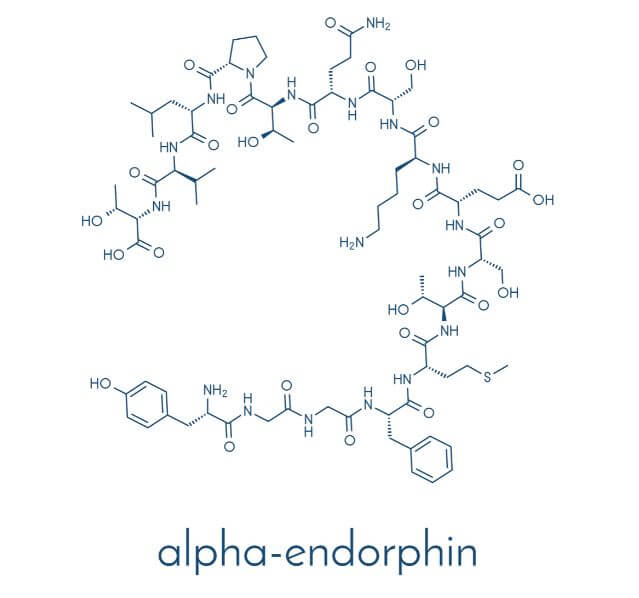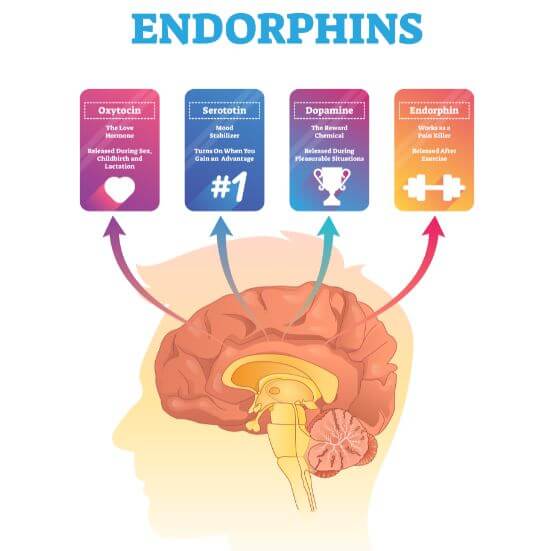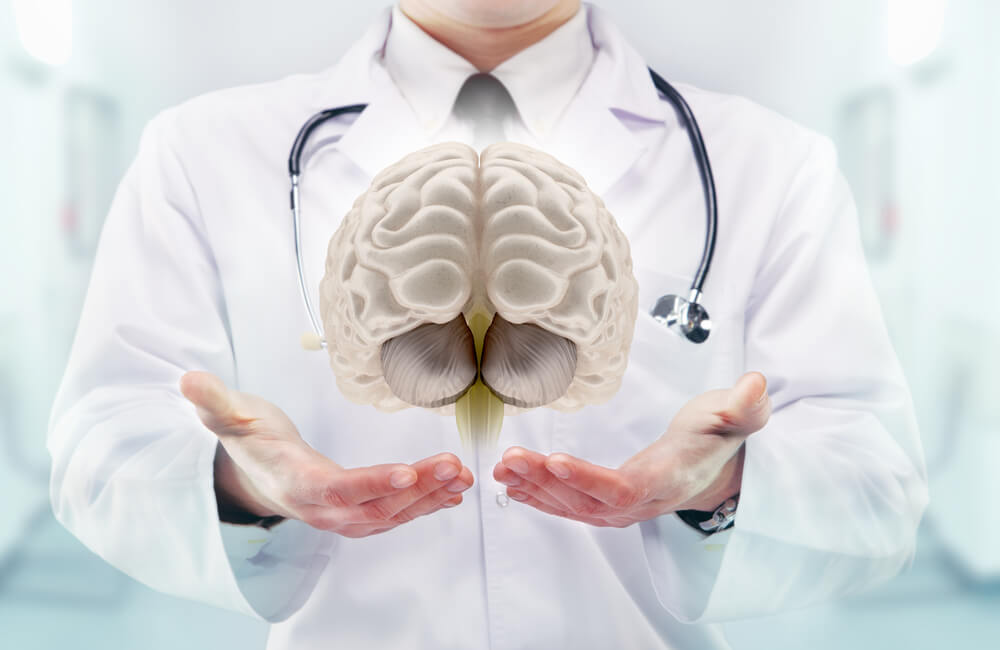What Are Endorphins?


Escrito y verificado por la psicóloga Paula Villasante
Endorphins are opioid neuropeptides that occur naturally in the body. These serve a primary function as an agent that blocks the perception of pain. In addition, they’re present when we feel pleasure.
Morphine receptors were discovered in the nervous system before the discovery of endorphins. This natural receptor spoke of the possibility of the existence and effect of endorphins which was later confirmed.
Later, it was discovered that these molecules don’t only function as neurotransmitters in the central nervous system, but they also appear to function as peptide hormones released into the circulatory system by the pituitary gland. Because of this, endorphins have been clinically linked to cases of mental problems.
Some of them are autism, depression, and depersonalization disorder. They have also been linked to activities such as vigorous aerobic exercise, and are also linked to laughter.
The molecular origin of endorphins
The origins of endorphins can be traced back to the proopiomelanocortin precursor polypeptide (POMC) that’s synthesized in the pituitary gland. Recent studies suggest that the immune system can also produce POMC. Consequently, they also provide a base source for the production of this neurotransmitter.
Proopiomelanocortin consists of a chain of 241 amino acids that is cleaved by the action of the enzyme (prohormones convertases) into the single chain polypeptide of 93 amino acids beta-lipoprotein (beta LPH).
Beta-LPH is divided through enzymes into the melanocyte-stimulating hormone beta and endorphins, among other types of molecules.
Alpha, beta, and gamma-endorphins

Endorphins are identified as three distinct peptides. These are alpha, beta, and gamma.
Beta-endorphins are the longest chain, containing 31 amino acids in the following sequence: Tyr-Gly-Gly-Phe-Met-Thr-Ser-Glu-Lys-Ser-Gln-Thr-Pro-Leu-Val-Thr -Le-Leu -Phe-Lys-Asn-Ala-Ile-Ile-Lys-Asn-Ala-Tyr-Lys-Lys-Gly-Glu. This sequence corresponds to amino acids 104 to 134 in the beta-LPH sequence.
The second longest chain is gamma-endorphins. This consists of a chain of 17 amino acids equal to the first sequence of the chain of 17 amino acids of the beta.
Finally, the third and shortest type are alpha-endorphins. Alphas are chains of amino acids that comprise the same first 16 amino acid sequence as beta. Consequently, it has the same sequence of the first 16 amino acids that comprise gamma-endorphins.
Therefore, the beta and gamma sequences essentially have the sequence of alpha-endorphins nested within them. This molecular configuration allows these molecules to be the agonist of opioid receptors.
These are the same receptors that opium-derived chemicals like morphine bind to in order to trigger physiological responses.
Function

The function of endorphins can be stated in general terms. However, it can also be specifically broken down and observed for each type of endorphin.
In general, the release of this neurotransmitter is understood to be associated with the body’s response to pain. But it’s also associated with exercise in the euphoria of a runner. The pain relief experienced as a consequence of endorphin release has been found to be greater than that of morphine.
Furthermore, they have been found to be associated with states of pleasure. These include the emotions caused by laughter, love, sex, and even tasty food.
Of the three types of endorphins, beta’s have been the most studied and prevalent. They represent most of the functional properties of endorphins when generalized and understood as a whole.
Research is being carried out on each type to better understand the full functional potential of each, along with how they can be used in a medically beneficial way.
Endorphins express functional duality. This is because they fall into the category of neurotransmitters or neuromodulators in the central nervous system (CNS) and also into the category of hormones in the pituitary gland.
Mechanism of action

The endorphin mechanism can be seen through two different lenses. On the one hand, through the peripheral nervous system (PNS) and on the other, through the central nervous system (CNS). In the PNS, the perception of pain relief occurs when beta-endorphins bind to opioid receptors.
Opioid receptors are divided into four classes of G-protein coupled receptors:
- Mu receptors
- Delta receptors
- Kappa receptors
- Nociceptin receptors
The greatest binding potential exists between beta-endorphins and mu receptors. These can be found along the nerves of the PNS.
When this binding of beta-endorphins to mu receptors occurs in nerve endings (occurring presynaptically or postsynaptically), we can observe analgesic effects.
The effects occur because the aforementioned binding causes a triggering of chemical events that prevent the release of substance P, among other tachykinins.
Just as the binding of beta-endorphins to mu opioids occurs in the peripheral nervous system, it also occurs in the central nervous system. However, there’s a difference: the mechanism triggered by the binding opposes the release of the inhibitory neurotransmitter gamma-aminobutyric acid (GABA) as opposed to substance P.
With this suppression of GABA, the result is an increase in the production and action of dopamine, pleasure, and the neurotransmitter associated with reward.
Clinical significance
From a clinical point of view, endorphins and their effects and interactions are still poorly understood. A basic but notable interaction of endorphins is with naloxone.
The case of naloxone

Naloxone is given as a drug. It’s generally used in the case of an opioid overdose to blunt the body’s response to the opioid.
This is accomplished by binding to opioid receptors. This makes it difficult not only for opioid binding but also for endorphin binding, which reduces the effect of available endorphins.
Studies have been conducted regarding the use of naloxone in the presence of a depersonalization disorder. In them, it was found that the patient’s conditions improved. Based on this, endorphins are suspected to be associated with contributing to this disorder.
The physical dependence on an opiate
Another interaction of clinical importance includes cases in which the patient is physically dependent on an opiate. Links have been established with opiate dependence and hypothalamic-pituitary-gonadal dysfunction.
This association has been made in research between the effects of dependence on gonadal homeostasis through the effective action of beta-endorphin.
So, it seems that research into endorphins still has a long way to go. Endorphins and their interactions in nervous system processes seem more extensive than we know of.
So, mainly, endorphins have to do with pleasure and pain, but, as we have seen, they’re also related to some disorders such as depersonalization disorder. In the future, research will shed some more light on these interactions.
Endorphins are opioid neuropeptides that occur naturally in the body. These serve a primary function as an agent that blocks the perception of pain. In addition, they’re present when we feel pleasure.
Morphine receptors were discovered in the nervous system before the discovery of endorphins. This natural receptor spoke of the possibility of the existence and effect of endorphins which was later confirmed.
Later, it was discovered that these molecules don’t only function as neurotransmitters in the central nervous system, but they also appear to function as peptide hormones released into the circulatory system by the pituitary gland. Because of this, endorphins have been clinically linked to cases of mental problems.
Some of them are autism, depression, and depersonalization disorder. They have also been linked to activities such as vigorous aerobic exercise, and are also linked to laughter.
The molecular origin of endorphins
The origins of endorphins can be traced back to the proopiomelanocortin precursor polypeptide (POMC) that’s synthesized in the pituitary gland. Recent studies suggest that the immune system can also produce POMC. Consequently, they also provide a base source for the production of this neurotransmitter.
Proopiomelanocortin consists of a chain of 241 amino acids that is cleaved by the action of the enzyme (prohormones convertases) into the single chain polypeptide of 93 amino acids beta-lipoprotein (beta LPH).
Beta-LPH is divided through enzymes into the melanocyte-stimulating hormone beta and endorphins, among other types of molecules.
Alpha, beta, and gamma-endorphins

Endorphins are identified as three distinct peptides. These are alpha, beta, and gamma.
Beta-endorphins are the longest chain, containing 31 amino acids in the following sequence: Tyr-Gly-Gly-Phe-Met-Thr-Ser-Glu-Lys-Ser-Gln-Thr-Pro-Leu-Val-Thr -Le-Leu -Phe-Lys-Asn-Ala-Ile-Ile-Lys-Asn-Ala-Tyr-Lys-Lys-Gly-Glu. This sequence corresponds to amino acids 104 to 134 in the beta-LPH sequence.
The second longest chain is gamma-endorphins. This consists of a chain of 17 amino acids equal to the first sequence of the chain of 17 amino acids of the beta.
Finally, the third and shortest type are alpha-endorphins. Alphas are chains of amino acids that comprise the same first 16 amino acid sequence as beta. Consequently, it has the same sequence of the first 16 amino acids that comprise gamma-endorphins.
Therefore, the beta and gamma sequences essentially have the sequence of alpha-endorphins nested within them. This molecular configuration allows these molecules to be the agonist of opioid receptors.
These are the same receptors that opium-derived chemicals like morphine bind to in order to trigger physiological responses.
Function

The function of endorphins can be stated in general terms. However, it can also be specifically broken down and observed for each type of endorphin.
In general, the release of this neurotransmitter is understood to be associated with the body’s response to pain. But it’s also associated with exercise in the euphoria of a runner. The pain relief experienced as a consequence of endorphin release has been found to be greater than that of morphine.
Furthermore, they have been found to be associated with states of pleasure. These include the emotions caused by laughter, love, sex, and even tasty food.
Of the three types of endorphins, beta’s have been the most studied and prevalent. They represent most of the functional properties of endorphins when generalized and understood as a whole.
Research is being carried out on each type to better understand the full functional potential of each, along with how they can be used in a medically beneficial way.
Endorphins express functional duality. This is because they fall into the category of neurotransmitters or neuromodulators in the central nervous system (CNS) and also into the category of hormones in the pituitary gland.
Mechanism of action

The endorphin mechanism can be seen through two different lenses. On the one hand, through the peripheral nervous system (PNS) and on the other, through the central nervous system (CNS). In the PNS, the perception of pain relief occurs when beta-endorphins bind to opioid receptors.
Opioid receptors are divided into four classes of G-protein coupled receptors:
- Mu receptors
- Delta receptors
- Kappa receptors
- Nociceptin receptors
The greatest binding potential exists between beta-endorphins and mu receptors. These can be found along the nerves of the PNS.
When this binding of beta-endorphins to mu receptors occurs in nerve endings (occurring presynaptically or postsynaptically), we can observe analgesic effects.
The effects occur because the aforementioned binding causes a triggering of chemical events that prevent the release of substance P, among other tachykinins.
Just as the binding of beta-endorphins to mu opioids occurs in the peripheral nervous system, it also occurs in the central nervous system. However, there’s a difference: the mechanism triggered by the binding opposes the release of the inhibitory neurotransmitter gamma-aminobutyric acid (GABA) as opposed to substance P.
With this suppression of GABA, the result is an increase in the production and action of dopamine, pleasure, and the neurotransmitter associated with reward.
Clinical significance
From a clinical point of view, endorphins and their effects and interactions are still poorly understood. A basic but notable interaction of endorphins is with naloxone.
The case of naloxone

Naloxone is given as a drug. It’s generally used in the case of an opioid overdose to blunt the body’s response to the opioid.
This is accomplished by binding to opioid receptors. This makes it difficult not only for opioid binding but also for endorphin binding, which reduces the effect of available endorphins.
Studies have been conducted regarding the use of naloxone in the presence of a depersonalization disorder. In them, it was found that the patient’s conditions improved. Based on this, endorphins are suspected to be associated with contributing to this disorder.
The physical dependence on an opiate
Another interaction of clinical importance includes cases in which the patient is physically dependent on an opiate. Links have been established with opiate dependence and hypothalamic-pituitary-gonadal dysfunction.
This association has been made in research between the effects of dependence on gonadal homeostasis through the effective action of beta-endorphin.
So, it seems that research into endorphins still has a long way to go. Endorphins and their interactions in nervous system processes seem more extensive than we know of.
So, mainly, endorphins have to do with pleasure and pain, but, as we have seen, they’re also related to some disorders such as depersonalization disorder. In the future, research will shed some more light on these interactions.
-
Chaudhry, S. R., & Bhimji, S. S. (2018). Biochemistry, Endorphin. In StatPearls [Internet]. StatPearls Publishing.
-
Gu, Z. H., Wang, B., Kou, Z. Z., Bai, Y., Chen, T., Dong, Y. L., … & Li, Y. Q. (2017). Endomorphins: promising endogenous opioid peptides for the development of novel analgesics. Neurosignals, 25(1), 98-116.
-
Guillemyn, K., Starnowska, J., Lagard, C., Dyniewicz, J., Rojewska, E., Mika, J., … & Chevillard, L. (2016). Bifunctional peptide-based opioid agonist–nociceptin antagonist ligands for dual treatment of acute and neuropathic pain. Journal of medicinal chemistry, 59(8), 3777-3792.
-
Lee, Y. S., Remesic, M., Ramos-Colon, C., Hall, S. M., Kuzmin, A., Rankin, D., … & Hruby, V. J. (2016). Cyclic non-opioid dynorphin A analogues for the bradykinin receptors. Bioorganic & medicinal chemistry letters, 26(22), 5513-5516.
-
Lima, L. B., Metzger, M., Furigo, I. C., & Donato Jr, J. (2016). Leptin receptor-positive and leptin receptor-negative proopiomelanocortin neurons innervate an identical set of brain structures. Brain research, 1646, 366-376.
-
Luan, Y. H., Wang, D., Yu, Q., & Chai, X. Q. (2017). Action of β-endorphin and nonsteroidal anti-inflammatory drugs, and the possible effects of nonsteroidal anti-inflammatory drugs on β-endorphin. Journal of clinical anesthesia, 37, 123-128.
-
Manninen, S., Tuominen, L., Dunbar, R. I., Karjalainen, T., Hirvonen, J., Arponen, E., … & Nummenmaa, L. (2017). Social laughter triggers endogenous opioid release in humans. Journal of Neuroscience, 37(25), 6125-6131.
-
Olorunmoteni, O. E., Adeodu, O. O., Oseni, S. B., & Obuotor, E. M. (2017). Cerebrospinal fluid and plasma β‐endorphin levels in children with cerebral malaria. Brain and behavior, 7(4), e00673.
-
Palus, K., Chrobok, L., Kepczynski, M., & Lewandowski, M. H. (2017). Enkephalin and neuropeptide-Y interaction in the intergeniculate leaflet network, a part of the mammalian biological clock. Neuroscience, 343, 10-20.
-
Pearce, E., Wlodarski, R., Machin, A., & Dunbar, R. I. (2017). Variation in the β-endorphin, oxytocin, and dopamine receptor genes is associated with different dimensions of human sociality. Proceedings of the National Academy of Sciences, 114(20), 5300-5305.
-
Rosa, M., Gonzalez-Nunez, V., Barreto-Valer, K., Marcelo, F., Sánchez-Sánchez, J., Calle, L. P., … & Valencia, G. (2017). Role of the sugar moiety on the opioid receptor binding and conformation of a series of enkephalin neoglycopeptides. Bioorganic & medicinal chemistry, 25(7), 2260-2265.
-
Stefanucci, A., Novellino, E., Mirzaie, S., Macedonio, G., Pieretti, S., Minosi, P., … & Mollica, A. (2017). Opioid receptor activity and analgesic potency of DPDPE peptide analogues containing a xylene bridge. ACS medicinal chemistry letters, 8(4), 449-454.
-
Wang, Y., Zhou, J., Liu, X., Zhao, L., Wang, Z., Zhang, X., … & Wang, R. (2017). Structure-constrained endomorphin analogs display differential antinociceptive mechanisms in mice after spinal administration. Peptides, 91, 40-48.
Este texto se ofrece únicamente con propósitos informativos y no reemplaza la consulta con un profesional. Ante dudas, consulta a tu especialista.







